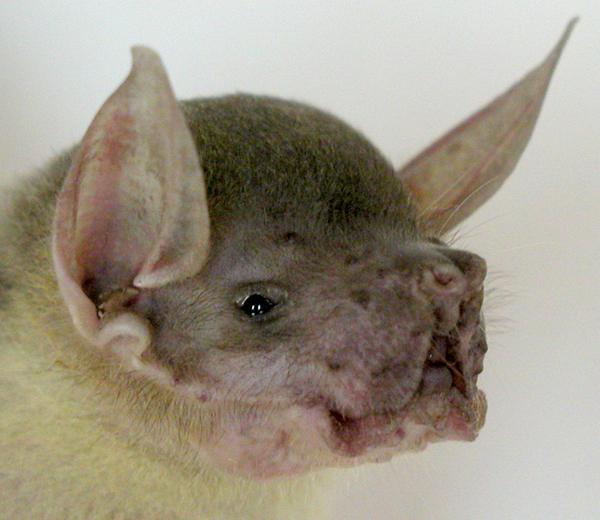Guide to the bats of Montserrat
Artibeus jamaicensis Chiroderma improvisum Brachyphylla cavernarum Noctilio leporinus Ardops nichollsi Sturnira thomasi Monophyllus plethodon Molossus molossus Tadarida brasiliensis Natalus stramineus Key to Roosts Key to Taxa

(Photo A. Hartpence)
(Photo R. Adams)Bulldog or Fisherman Bat - Noctilio leporinus
STATUS: Fishing bats are found in lowland and coastal habitats over a large area of Central and South America, and throughout the Caribbean. Often locally abundant, they are restricted by the availability of large fresh-water sources (reservoirs, lakes, ponds, rivers).
IDENTIFICATION: The fishy smell, russet-orange color, white stripe of fur down the center of the back, and the extremely large feet (20mm long = longer than the bats' head) readily distinguish this large bat from anything else in the region. The large square head give this bat one of it's alternate names - the Bulldog bat. The long thin pointed ears are also distinctive, but may be curled back against the head if the bat is undisturbed. The large wingspan and the relatively stiff-looking, slow flight close over the surface of calm water (like pond, lagoons, surf-line) are typical of Fishing bats. Repeated splashes as the feet are dipped into water to catch fish or insects can also sometimes be heard. The tail membrane is very large and is supported by a long spur (calcar) of cartilage growing from each ankle. These spurs are moveable, and allow the tail membrane to be rolled up like a sail between the back legs so that it does not interfere with catching fish. The fur is very short and ranges from brown-orange to yellow in color.
ROOSTS: Hollow trees, dark sea caves, and crevices in rock-overhangs are commonly used as roosts by these bats. Fishing bats and their roosts have a characteristic fishy odor which is unmistakable.
DIET: As their name implies, these bats trawl for fish and large insects by dragging their large feet across the water's surface, hoping to gaff their dinner with their impressive claws. When times get hard, Fishing bats can subsist on large flying beetles and small crabs that they can snag along the surf-line. Their large drooping cheeksallow the bat to stuff minnows or partly chewed food into its cheeks and yet continue to hunt. Their droppings are large (15-20mm long, 3-4mm in diameter) and irregularly shaped. The droppings often look silvery because of the tiny fish scales they contain; if the bats have been eating shrimps or small crabs, the droppings may be pink or orange.
REPRODUCTION: Mating probably occurs around December, with a single pup being born the next April or May. Possibly there is a second mating season soon after the females have given birth, with this second baby being born around November the same year.
SIZE: Forearm length - 86 mm (range 84-93mm); Mass - 64g (range 60-70g); Wingspan - approx. 600mm; Head+body length - approx. 120-130mm.
COMMENTS: Other names Greater bulldog bat, Fisherman bat.
REFERENCES: Mammalian Species No. 216: Noctilio leporinus by Craig S. Hood & J. Knox Jones, Jr. 7pp (American Society of Mammalogists, 1984)
See Entry: Walker's Mammals of the World Online version 5.1, by Ronald Nowak, 1997


